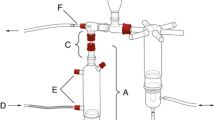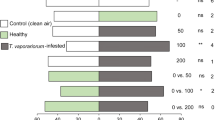Abstract
We compared the volatiles of JA-treated plants of six rice varieties and then determined, in the laboratory and field, if they differed in attractiveness to Anagrus nilaparavate Pand et Wang, an egg parasitoid of rice planthoppers. Analyses of volatiles revealed significant differences among varieties, both in total quantity and quality of the blends emitted. On the basis of these differences, the six varieties could be roughly divided into three groups. In a Y-tube olfactometer, female wasps preferred odors from two groups. These preferences corresponded to observed parasitism rates in a field experiment. A comparison of the volatiles with results from behavioral assays and field experiments indicates that the quality (composition) of the blends is more important for attraction than the total amount emitted. The results imply that the foraging success of natural enemies of pests can be enhanced by breeding for crop varieties that release specific volatiles.




Similar content being viewed by others
References
Bukovinszky, T., Gols, R., Posthumus, M. A., Vet, L. E. M., and Van Lenteren, J. C. 2005. Variation in plant volatiles and attraction of the parasitoid Diadegmasemiclausum (Hellén). J. Chem. Ecol. 31:461–480.
Cheng, J. and He, J. 1996. Rice Insect Pests. China Agricultural Press, Beijing.
D’Alessandro, M. and Turlings, T. C. J. 2005. In Situ modification of herbivore-induced plant odours: A novel approach to study the attractiveness of volatile organic compounds to parasitic wasps. Chem. Senses 30:739–753.
D’Alessandro, M. and Turlings, T. C. J. 2006. Advances and challenges in the identification of volatiles that mediate interactions among plants and arthropods. Analyst 131:24–32.
De Moraes, C. M., Lewis, W. J., Paré, P. W., Alborn, H. T., and Tumlinson, J. H. 1998. Herbivore-infested plants selectively attract parasitoids. Nature 393:570–573.
Degen, T., Dillmann, C., Marion-Poll, F., and Turlings, T. C. J. 2004. High genetic variability of herbivore-induced volatile emission within a broad range of maize inbred lines. Plant Physiol. 135:1928–1938.
Dicke, M. 1999. Specificity of herbivore-induced plant defences, pp. 43–59, in D. J. Chadwich and J. Good (eds.). Insect–Plant Interactions and Induced Plant Defence. Novartis Foundation Symposium 223. Wiley, Chichester, United Kingdom.
Dicke, M., Sabelis, M. W., Takabayashi, J., Bruin, J., and Posthumus, M. A. 1990. Plant strategies of manipulating predator–prey interactions through allelochemicals: Prospects for application in pest control. J. Chem. Ecol. 16:3091–3118.
Fatouros, N. E., Van Loon, J. J. A., Hordijk, K. A., Smid, H. M., and Dicke, M. 2005. Herbivore-induced plant volatiles mediate in-flight host discrimination by parasitoids. J. Chem. Ecol. 31:2033–2047.
Flint, H. M., Salter, S. S., and Walters, S. 1979. Caryophyllene: An attractant for the green lacewing. Environ. Entomol. 8:1123–1125.
Fritzsche-Hoballah, M. E., Tamò, C., and Turlings, T. C. J. 2002. Differential attractiveness of induced odors emitted by eight maize varieties for the parasitoid Cotesia marginiventris: Is quality or quantity important? J. Chem. Ecol. 28:951–968.
Halitschke, R., Schittko, U., Pohnert, G., Boland, W., and Baldwin, I. T. 2001. Molecular interactions between the specialist herbivore Manduca sexta (Lepidoptera, Sphingidae) and its natural host Nicotiana attenuata. III. Fatty acid-amino acid conjugates in herbivore oral secretions are necessary and sufficient for herbivore-specific plant responses. Plant Physiol. 125:711–717.
Heath, R. R. and Manukian, A. 1992. Development and evaluation of systems to collect volatile semiochemicals from insects and plants using a charcoal-infused medium for air purification. J. Chem. Ecol. 18:1209–1226.
Hopke, J., Donath, J., Blechert, S., and Boland, W. 1994. Herbivore-induced volatiles: The emission of acyclic homoterpenes from leaves of Phaseolus lunatus and Zea mays can be triggered by a β-glucosidase and jasmonic acid. FEBS Lett. 352:146–150.
Janssen, A., Van Alphen, J. J. M., Sabelis, M. W., and Bakker, K. 1995. Specificity of odour-medeated avoidance of competition in Drosophila parasitoids. Behav. Ecol. Sociobiol. 36:229–235.
Janssen, A., Bruin, J., Jacobs, G., Schraag, R., and Sabelis, M. W. 1997. Predators use volatiles to avoid prey patches with conspecifics. J. Anim. Ecol. 66:223–232.
Kappers, I. F., Aharoni, A., Van Herpen, T. W. J. M., Luckerhoff, L. L. P., Dicke, M., and Bouwmeester, H. J. 2005. Genetic engineering of terpenoid metabolism attracts bodyguards to Arabidopsis. Science 309:2070–2072.
Kessler, A. and Baldwin, I. T. 2001. Defensive function of herbivore-induced plant volatile emissions in nature. Science 291:2141–2144.
Krips, O. E., Willems, P. E. L., Gols, R., Posthumus, M. A., Gort, G., and Dicke, M. 2001. Comparison of cultivars of ornamental crop Gerbera jamesonii on production of spider mite-induced volatiles, and their attractiveness to the predator Phytoseiulus persimilis. J. Chem. Ecol. 27:1355–1372
Lewis, W. J. and Tumlinson, J. H. 1988. Host detection by chemically mediated associative learning in a parasitic wasp. Nature 331:257–259.
Lou, Y. 1999. Role of infochemicals in host selection behavior of Anagrus nilaparvatae Pang et Wang. Ph.D. dissertation, Zhejiang University, Hangzhou, China.
Lou, Y., Du, M., Turlings, T. C. J., Cheng, J., and Shan, W. 2005a. Exogenous application of jasmonic acid induces volatile emissions in rice and enhances parasitism of Nilaparvata lugens eggs by the parasitoid Anagrus nilaparvatae. J. Chem. Ecol. 31:1985–2002.
Lou, Y., Ma, B., and Cheng, J. 2005b. Attraction of the parasitoid Anagrus nilaparvatae Pang et Wang to rice volatiles induced by the rice brown planthopper Nilaparvata lugens (Stål). J. Chem. Ecol. 31:2357–2372.
Loughrin, J. H., Potter, D. A., and Hamilton-Kemp, T. R. 1995. Volatiles emitted by different cotton varieties damaged by feeding beet armyworm larvae. J. Chem. Ecol. 21:1217–1227.
Ma, B., Lou, Y., and Cheng, J. 2004. Effects of some biotic factors on activities of the volatiles emitted from rice plants infested by the rice brown planthopper, Nilaparvata lugens (Stål). J. of Zhejiang Univ. (Agriculture and Life Science) 30(6):589–595.
Rasmann, S., Köllner, T. G., Degemhardt, J., Hiltpold, I., Töpfer, S., Kuhlmann, U., Gershenzon, J., and Turings, T. C. J. 2005. Recruitment of entomophatogenic nematodes by insect-damaged maize roots. Nature 434:732–737.
Rubia-Sanchez, E., Suzuki, Y., Miyamoto, K., and Watanabe, T. 1999. The potential for compensation of the effects of the brown planthopper Nilaparvata lugens (Stål) (Homoptera: Delphacidae) feeding on rice. Crop Prot. 18:39–45.
Schnee, C., Köllner, T. G., Held, M., Turlings, T. C. J., Gershenzon, J., and Degenhardt, J. 2006. A maize terpene synthase contributes to a volatile defense signal that attracts natural enemies of maize herbivores. Proc. Natl. Acad. Sci. USA. 103:1129–1134.
Scutareanu, P., Drukker, B., Bruin, J., Posthumus, M. A., and Sabelis, M. W. 1997. Volatiles from psylla-infested pear trees and their possible involvement in attraction of anthocorid predators. J Chem. Ecol. 23:2241–2260.
Takabayashi, J. and Dicke, M. 1996. Plant–carnivore mutualism through herbivore-induced carnivore attractants. Trends Plant Sci. 1:109–113.
Thaler, J. S. 1999. Jasmonate-inducible plant defences cause increased parasitism of herbivores. Nature 399:686–688.
Turlings, T. C. J. and Wäckers, F. L. 2004. Recruitment of predators and parasitoids by herbivore-damaged plants, pp. 21–75, in R. T. Cardé and J. Millar (eds.). Advances in Insect Chemical Ecology. Cambridge University Press.
Turlings, T. C. J., McCall, P. J., Albornl, H. T., and Tumlinson, J. H. 1993a. An elicitor in caterpillar oral secretions that induces corn seedlings to emit chemical signals attractive to parasitic wasps. J. Chem. Ecol. 19:411–425.
Turlings, T. C. J., Wäckers, F. L., Vet, L. E. M., Lewis, W. J., and Tumlinson, J. H. 1993b. Learning of host-finding cues by hymenopterous parasitoids, pp. 51–78, in D. R. Papaj and A. C. Lewis (eds.). Insect Learning. Ecology and Evolutionary Perspectives. Chapman & Hall, New York.
Turlings, T. C. J., Lengwiler, U. B., Bernasconi, M. L., and Wechsler, D. 1998. Timing of induced volatile emissions in maize seedlings. Planta 207:146–152.
Van Den Boom, C. E. M., Van Beek, T. A., Posthumus, M. A., Groot, A., and Dicke, M. 2004. Qualitative and quantitative variation among volatile profiles induced by Tetranychus urticae feeding on plants from various families. J. Chem Ecol. 30:69–89.
Vet, L. E. M. and Dicke, M. 1992. Ecology of infochemicals use by natural enemies in a tritrophic context. Annu. Rev. Entomol. 37:141–172.
Vet, L. E. M. and Groenewold, A. W. 1990. Semiochemicals and learning in parasitoids. J. Chem. Ecol. 16:3119–3135.
Watanabe, T. and Kitagawa, H. 2000. Photosynthesis and translocation of assimilates in rice plants following phloem feeding by the planthopper Nilaparvata lugens (Homoptera: Delphacidae). J. Econ. Entomol. 93:1192–1198.
Zhu, L., Zhu, C., Weng, Q., Huang, Z., and He, G. 2004. Research progress on brown planthopper resistance genes in rice. Hubei Agric. Sci. 1:19–24.
Acknowledgments
We thank Wenwen Song, Guoxin Zhou, and Xia Wang for assistance with laboratory work. The study was sponsored by the Ministry of Science and Technology of China (973) (G2000016208), the National Natural Science Foundation of China (30270233, 30370960), the Program for New Century Excellent Talents of the Ministry of Education of China (NCET-04-0534), and the Innovation Research Team Program of the Ministry of Education of China (IRT0355).
Author information
Authors and Affiliations
Corresponding authors
Rights and permissions
About this article
Cite this article
Lou, Y., Hua, X., Turlings, T.C.J. et al. Differences in Induced Volatile Emissions among Rice Varieties Result in Differential Attraction and Parasitism of Nilaparvata lugens Eggs by the Parasitoid Anagrus nilaparvatae in the Field. J Chem Ecol 32, 2375–2387 (2006). https://doi.org/10.1007/s10886-006-9151-7
Published:
Issue Date:
DOI: https://doi.org/10.1007/s10886-006-9151-7




